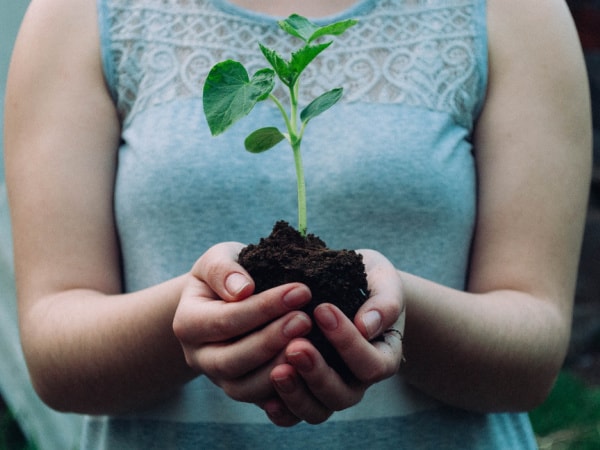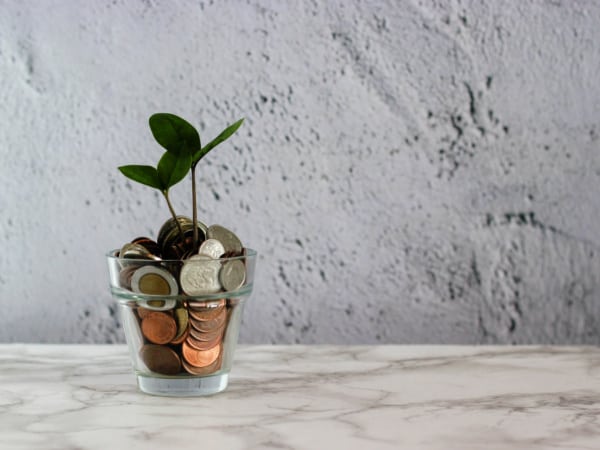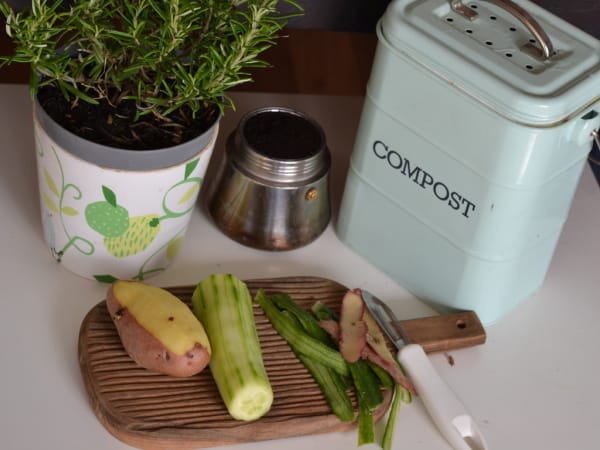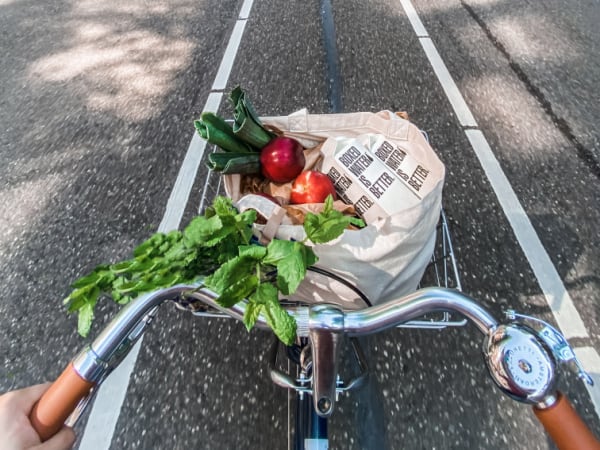Sustainability and low-budget life go together in many ways. Today I will show you ways to live a more environmentally friendly and wallet-friendly life. The positive side effect of living this way is that your life also becomes less complicated.
(Links in this post are affiliate links. I will be compensated when you make a purchase by clicking those links. See my disclosure page for more information)
How To Live A Simple And Eco-Friendly Life And Save Money
1. Eat Out Less
Fast food is not just expensive; it also creates a large amount of waste.
2. Buy In Bulk
I don’t mean buying the ginormous boxes full of snack portioned foods that you find in the big box stores that require memberships. Avoid the pre-portioned items and instead look for the large container of trail mix, the giant can of peaches, which are generally cheaper per ounce than their single-serving counterparts and create a lot less landfill-bound waste. However, don’t buy the large size if you know your family won’t eat all of it before it expires; that is a waste of money and isn’t environmentally friendly either.
To make these items more convenient for our grab-and-go world, when you get home from the store, divide them into realistic servings sizes using reusable dishwasher-safe ziplock bags or another type of reusable food storage container.
3. Invest In One-Time Purchases That Will Help You Avoid Single-Use Items
Frugal people are not against spending money and living a sustainable lifestyle doesn’t mean you never buy anything new. Instead, the prospect of new purchases are looked at as investments that can help us save money and reduce our carbon footprint post-purchase.
For instance, a quality stainless steel water bottle will help you save money by avoiding buying beverages while you are out and about. That same reusable water bottle reduces the need for single-use plastics.
4. Use Things To The Last Drop
There is an old saying, “Use it up–wear it out–make do–or do without.” This saying goes through my mind as I am using my clipboard full of paper that has been used only on one side to make a list. Or when I am snipping open a lotion bottle to scrape out the last of the lotion inside.
5. Own Less
I grew up with a mom who I heard say over and over while we were clothes shopping, “one on, one for the wash, and one to spare.” Not many people, including myself, follow that rule these days; however, we could benefit by setting limits to how much of each thing we need. For me, that means I don’t own more clothes than what fits neatly in my dresser and small closet. And that is just one physical limit I put on my possessions. I have plenty more that I have created to help me to keep my collections under control.
Owning less isn’t just good for our pocketbooks and earth. It also uncomplicates our lives. When we own less, we have less to clean and less to repair, which simplifies our lives.
6. Find New Uses For Items
Instead of looking at old things and thinking of ways to reuse them, which often leads to hoarding items we won’t ever get around to repurposing, try this. The next time you feel you need to go and buy something, spend 15 to 30 minutes searching your home for something that could serve that purpose with just a bit of tweaking.
7. Grow it yourself
This thrifty person has a brown thumb, so I shop local farmers’ markets to support those with green thumbs and reduce my carbon footprint at the same time, plus the veggies are cheaper there than at the supermarket.
However, if you have a green thumb, use it to grow a bit of the food that you eat. Start with something small like growing a few potted herbs in your kitchen window, and then work your way up to a square foot vegetable garden in the backyard.
If you don’t have a backyard, that doesn’t mean you can’t grow a few vegetables—research container gardening.
8. Shop In Season
Shopping for fruits and vegetables in season isn’t just part of a frugal lifestyle. It is also part of the environmentally friendly lifestyle. Seasonal produce is cheaper because it hasn’t had to be transported as far, which means fewer fossil fuels.
9. Borrow And Lend
My favorite way to find items to borrow is to do what I call the Facebook shout-out and it hasn’t failed me yet. It is super simple, next time you need something that you know you are only going to use that one time, hop over to Facebook and write the word HELP (yes, all in capitals) and then follow it with a request to borrow the item you need, as well as when you need it and how long. And always make sure to say thanks at the end of your request.
I have borrowed several coolers for a summer party, a pair of crutches for a broken leg, and a few space heaters when our furnace decided to stop working in below-freezing temperatures.
Borrowing didn’t just save me money; it also meant fewer items needed to be produced, reducing the strain on our natural resources with each borrow instead of buy.
Of course, I think this system works so well for our family because people know we are just as willing to lend our items to them if they should have the need.
10. Swap
I have been to a few clothing swap parties over the years and always come home with great items to add to my wardrobe. I have also attended a ski equipment swap that was complicated but fair. You left with things worth the same as those you swapped them for, but you got the new size you needed. I have also been to a simple “throw your lightly worn soccer cleats and shin-guards in this bucket, and feel free to take out a pair in the next size up for this season” soccer equipment swap.
But there are plenty of other swap events you can host. Here is a list of ten that you can enjoy with your frugal and sustainable friends. And here is a list of swap events you could host during Christmas time to save you money and time.
11. Buy Secondhand
If you can’t borrow it and you can’t swap what you have for what you need, then the next best frugal and sustainable thing to do is buy the item secondhand.
Whether it be Goodwill shopping, yard sale shopping, thrift store shopping, or secondhand curriculum sales, our family loves the money we save by buying secondhand. Plus, it reduces the need to manufacture more, thus reducing pollution.
12. Buy The Most Energy Efficient Product You Can Afford
Remember that appliances come with more costs than just the purchase price. There is the cost for repairs and the power they use. For example, a super-cheap ancient freezer will use way more electricity each year you own it than one that is priced higher, but is only a few years old.
13. When You Are Done With An Item Sell It, Donate It, Or Give It To A Friend
Instead of tossing your castoff items to the curb, resell them through Facebook, Craigslist, eBay, or other avenues, to help others live frugal, sustainable lives. Or donate them to a locally owned thrift store where the proceeds go to issues you wish to support.
You could also do a Facebook shout-out with pictures attached of items you no longer want, stating you pick them up by a specific date and they are yours for free. There are also local “buy nothing” Facebook groups in some communities. In these groups, you can list items for others to pick up and take away with no money exchanged.
You can probably tell by now that I am a big fan of using Facebook to save money, live a little greener, and simplify life.
14. Reduce Your Electricity Consumption
These four points will help you lower your utility bills and reduce your environmental impact at the same time.
Here are a few simple ways to save money on your electric bill
- Use a clothesline or drying rack instead of a dryer. We have two of these drying racks and use them outside in the summer and inside in the winter.
- Set your air conditioning to 78 degrees
- Wash your clothes in cold water.
15. Use Less Water
Here are a simple few ways to reduce your water bill
- Run your dishwasher and washing machine only when you have full loads.
- Turn the tap off while brushing your teeth.
- Install inexpensive low-flow high faucet aerators on all your sinks.
These three simple tips will save gallons of water each day with little effort.
16. Generate Less Waste
Here are a few simple ways to reduce your trash bill by producing less garbage
- Start composting your food scraps. If you don’t garden, perhaps a neighbor does and would love it if you added your veggie peelings and other compostable items to their compost.
- Eliminate as many single-use products as your comfort level allows. The majority of people will find it easy to reduce or eliminate paper towels by using Swedish dishcloths. However, I am betting that only a tiny percentage will be willing to ditch their paper facial tissues for cloth hankies next time they catch a cold.
17. Turn Down The Heat
Whenever one of my children complains that the house’s temperature is too cold, I always look at what they are wearing first. If they don’t have socks on or are not wearing a sweater, I tell them to go and get those things on. Usually, when they do, they suddenly are not cold anymore.
According to Energy.gov, the ideal temperature for your home in the winter is 68 degrees during the day when you are home. The site also recommends turning your thermostat down even lower when you are sleeping or away from your home.
18. Consider Greener Forms Of Transportation
Get your workout done while knocking off a few errands on your to-do list. Bonus, you save money on fuel and reduce carbon emissions.
You might not be able to walk or bike from home, but perhaps you can drive and park in one area and then walk to several different errand locations nearby.
If your town is bike-friendly, consider purchasing an e-bike so that you can reach destinations that are further away than you generally like to pedal, thanks to the assistance of the motor that is powered by a rechargeable battery.
Utilizing public transportation is another great way to save money and the planet. Plus, you can get a few things done when you are not the driver.
Another way to reduce your transportation costs and be more eco-friendly is carpooling. Carpooling might decrease your commute time through less time spent in traffic due to using the carpool lanes.
19. Combine Errands As Much As Possible
Batching errands saves time, money, and fossil fuels. I like to keep a running list of errands I need to run, then when one of them becomes urgent, I look at the entire list and plan out the best route to complete them all in the shortest amount of time.
20. DIY It
The most straightforward DIY project that saves the most money and is a good environmentally friendly practice is making household cleaners. There are recipes all over the internet that use essential ingredients like vinegar and baking soda to create cleaners to clean every part of your home.
21. Take Care Of It
Things last longer when you take the time to maintain them, and the longer they last, the less of them you need to buy during your lifetime–saving money and reducing waste.
22. Make The Library Your Best Friend
You can gain much more from your library than just books to borrow. Libraries often have DVDs, Music and Audio CDs, Homeschooling curricula, and more to borrow. Plus, many libraries hold lectures where you can learn things like gardening skills, knitting and crocheting, and more.
Every library is unique, so make sure to check out all that your library offers.
23. Search The Alley
I will never forget when I visited a friend shortly after she had moved into her first apartment. I admired her beautiful wooden table and a few other pieces of furniture in her home. I shared how much I liked them, and she said, “thanks, I found them in an alley.” She then proceeded to tell me about this one week of the year when one of the more wealthy neighborhoods of the city she lived in had a large item garbage removal service come through.
On that week, people drive through their neighborhood picking up the items before they get picked up by the trash trucks. It is widely known that the people in the community are okay with this happening, and because they are OK with it, they tend to put out items that are much too nice to be heading to the trash, but they can’t be bothered to sell.
In our town, if you put something out in the alley next to but not in your trash bin, it is considered fair game for the taking. I once met a lady who funded a week-long trip by cleaning, repurposing, and then selling alley treasures.
24. Give It A Makeover
Give old items a new look before deeming them no longer usable or wearable. Enter your item and makeover into Pinterest for ideas.
25. Go Tiny
Small house, small vehicle, small impact. No, I don’t think every family, regardless of size, needs to live in a 400 square foot house and own a compact car. That isn’t feasible. I do think, however, that many families need to evaluate what they really need in a home and a vehicle. Buying the least amount you need will save money, reduce your carbon footprint and simplify your life.
26. Switches That Save Money And Reduce Waste
When my kids were little, I used environmentally friendly liquid soap mixed with water in foaming soap containers in the shower and the bathroom sink. I also used it for dish soap when the kids started helping with the dishes. I did this to save money and reduce the number of plastic bottles we used.
Now that my husband and I live alone part of the year in an RV, I have switched over to using bar soap in the shower (it would have been too messy with numerous kids using it and forgetting to place it in an area to dry). We have also started using shampoo bars. We like Trader Joe’s brand of both body soap and shampoo soap. Soap bar products save us even more money and reduce our dependence on plastic bottles even further.
27. Stop Buying Certain Items
Content creators who are also minimalists produce “What I No Longer Buy” videos and blog posts. If you want to live a thrifty, environmentally friendly life, watch or read a few of these articles.
Here are a few things I don’t buy
- Dryer sheets: Once I had a child whose skin is sensitive to these products, I gave them up and never looked back. Rarely have I had an issue with static. I tried dryer balls, but I didn’t think they did anything and they were a pain to find in the dry load and then throw back in the dryer with the next load.
- Fabric softener: Again, my sensitive skin child caused me to give this up, and I don’t miss it.
- Shaving Cream: I use the conditioner I use in my hair; it works without the need for an aerosol container.
28. Change Your Eating Habits
I touched on this briefly when I said we don’t eat out all that often, usually once a week. But there are a few more things you can do in the kitchen that will reduce your bills and impact the earth.
- Create a meal plan based on what you already have in the house. This will reduce food waste.
- Don’t make meat the center of your meal; instead, make it more of a topping or an add-in.
- Eat vegan or vegetarian meals at least one night a week or more.
29. Reduce, Then Recycle
Recycling is not the golden crown of living a sustainable life. It is more of a last resort, and even then, it isn’t necessarily a good one. It is rumored that very little that is sent to the recycling plants is recycled. Instead, the majority of it ends up going to landfills. I am not saying that you should give up on recycling. Instead, I am saying that you should concentrate more on reducing items.
Now, these items won’t help your frugality unless, of course, recycling isn’t an option in your area, then it could reduce your trash fees. This is why I thought I should mention them in this post.
Here are a few ways you can reduce the number of items headed for recycling centers
- Opt-out of as much junk mail as you can. I googled “how to opt-out of junk mail” a few years back and ended up being directed to a website where you can enter your information and get taken off the majority of mailing lists. I was hesitant about whether it would work or not but figured I had nothing to lose. It worked! I still get some junk mail, but it is a fraction of what I got before. Unfortunately, I can’t remember the exact website I used, so I can’t share it with you.
- If you enjoy reading free magazines as I do, choose the digital subscription over the print subscription if it is offered.
- Reduce the number of one-time use items you use (this point has been mentioned a few times because it is critical in living a simple, low-cost sustainable life).
30. Hold Off On Upgrading Electronics
Electronic waste is growing in our device-filled world. Help reduce it by taking care of and hanging onto your smartphones, tablets, laptops, TVs, and other gadgets until they really can’t keep up with your needs. Doing so will also lower your expenses.
31. Ask Yourself This Question Before Buying Anything
I am going to make you click over to this post to find out what the question is. However, I will let you know that it is a powerful question that doesn’t take long to answer and will save you money and reduce your carbon footprint more than any other question you might ask yourself.
More Frugal Living & Environmentally Friendly Living Posts
- The Ultimate Zero Waste Guide For Upcycling Or Repurposing Clothing
- How To Reduce Paper Clutter Without Going 100% Digital
- How To Have A Successful Staycation: Relax & Have Fun Close To Home
Become A Snail Pacer
Receive a weekly newsletter full of tips for making life changes at a realistic pace.











Leave a Reply